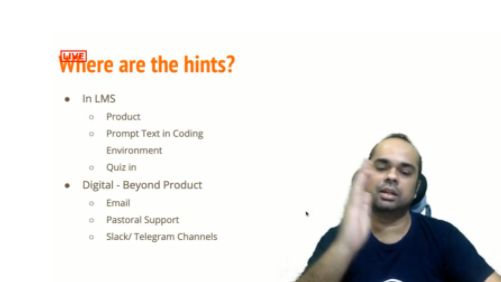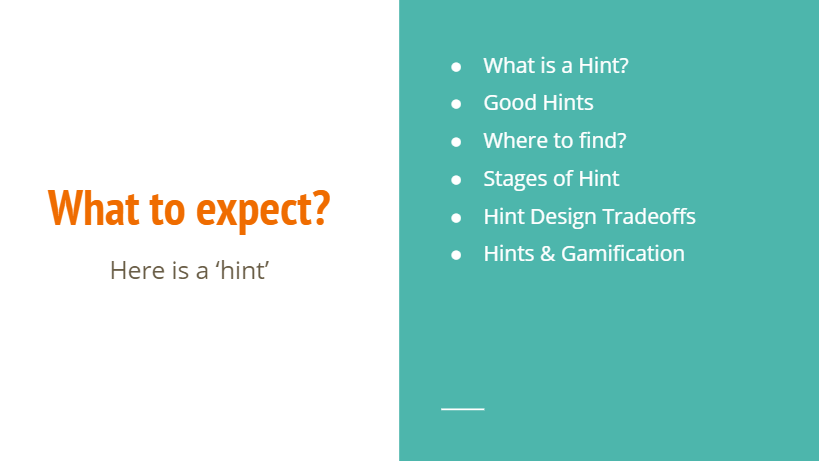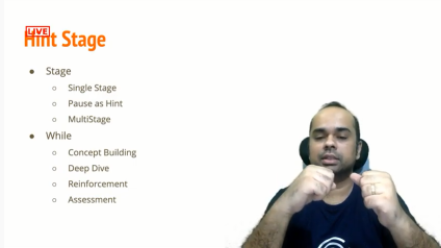Hints are very important as it not only helps the user to understand the concept but also proves to be a great guide for learning. Hints let you struggle to know the right answer by yourself, it directly doesn’t give you the answer but lets you search on your own which is quite useful for learning. In this blog you will also get to know the three stages of a hint and much more.
- Words:2737
- Type:Post + Video + Slides
- Video:1
- Slides:1
- Topic: Humans Of EdTech
- Time:16 Minutes
Hi, guys, welcome to another episode of the Humans of EdTech. And today we have with you what we call as the “Hintstones”. I think it’s a practical guide to design hints in modern LMS.
So I think it’s a very small topic to speak, but I think it has a very important implication on how people go about using or not using the software going forward.
So let’s just quickly jump into this particular thing. Right, hintstone is popularly inspired from Flintstones, but you know, that’s what we have.
So quickly moving ahead, I think what we’re going to look at today is what is a good hint? What is a hint? Where do you find it? What are the stages of the hint and some of the hint design tradeoffs and you know how hintstone and gamification typically go together.
So I think it’s a really preliminary introduction kind of a video. And what I really want to bring over here is my experience. I’m sure you must have an experience of having used multiple EdTech platforms, various learning platforms for various skills, whether they were dominantly, video based, you know, learn by doing, or typically even consuming content.
I’m sure you must have come across this particular element and dominantly in the assessments or the questionnaire or the quiz part of it, but it is also equally relevant when you are doing some amount of concept building or learning aspect of it. So we’ll just quickly you know, jump into this particular part.
All right, so, you know, what the hint is basically no, I think a slight indication of suggestion, it’s just not suggesting you, it pushes you that kind of thing.
I think it has a very critical function. So when anyone is picking up a skill, they are learning a language which typically is a function of developing some amount of understanding, having a fair amount of muscle memory going into it, they will get stuck and getting stuck is not a bad thing.
Getting stuck is a good thing. What is important when you get stuck is that you struggle it out, you slug it out and you actually overcome that part where you either know, follow the typical read, ask, search, kind of method that you read about it, you searched about it, you asked people how do you solve this particular thing? And that drills it down deeper or, and, OR or AND and both.

You used a relevant hint that was available, that was facilitated to you by the subject matter expert in that particular case. In a very physical classroom kind of context, we typically see a lot of people getting stuck.
And when they are stuck, we want to just show them the right direction or show them the direction where they are able to free themselves up and apply once again, not necessarily give them an answer, because giving them an answer is making them lazy.
It’s about developing that, you know, mental pathway that, okay, there’s gonna be someone who’s gonna have a human answer, and that comfort is not good. So hint, essentially serves the same purpose.
It impacts two very, very important things, what is the learner outcomes, the academic side of things. And second is if you have a self paced platform, or for that matter, even a guided platform, it somewhere has a very deep impact on adoption. It has an impact on the revenue consideration that typically your product is able to generate.

So quickly moving on from here. You know, what is a good hint? What does it look like? So, a good hint is difficult to build, you need to have a very, very strong understanding of how the learning typically happens in the mind of the user.
And you know, where exactly is this person stuck. That is when a good head can actually be built. So that’s where good hints are built by really, really awesome mentors, instructors and subject matter experts, because they have the experience of having taught the same topic in the online or a classroom environment.
What does a good hint look like?
A good hint, typically adds more information, it reduces the cognitive load, it makes you I would not say think less, but okay, it takes away that stress, that anxiety that now we know a little bit more and maybe I think you’re able to either unlock an application level or even able to try a few things extra where you might be able to reach the answer. It may be a single step, it may be a multi step. A good hint is not an answer.
And this is the most common pattern that you will see in a lot of online coding platforms where, you know, you Your task is basically to declare an array. But the hint is basically, okay, declare an array with elements A, B, and C. And they actually write out the whole syntax, you know, you just need to is, instead of is you just need to put the equal sign and things are done.
It is not a question. It doesn’t it’s not a rhetorical question, it doesn’t add to the confusion, or does not lead on anything of that sort. It’s a simple piece of information, which just adds partially to the end goal, or the objective of the task on hand.
And it definitely cannot be confusing. It cannot be cryptic, it has to be something more straightforward. But you will be surprised to find this anti pattern very, very frequently across multiple things. I’m really tempted to put screenshots here, but I’m just staying away from a lot of these things.
Where are these things in the learning management system in an online system, they are in the product. Either when you are solving something with video recording something and my background and my input and expertise is largely on coding platforms or people where they learn technology, either watching videos about learning, you know, solving things.
So it can be in the, you know, product in those assignments, whether it is true or false. Whether it is multiple choice questions, that’s where the hint can come in.
When you’re coding, it can come as a prompt where the instructor encourages you to pause and say that why don’t you now go and, you know, take this particular assignment on your own, and I think we can always keep on continuing and then see what the whole thing is all about, and it’s kind of always definitely be in the quiz.
Hints are not only restricted to the online environment, but if you are beyond outside the product, say in a Slack channel or you know, email, or you’re using some sort of a telegram group and you’re using some sort of a bot, even those particular places where you find a lot of these hints at play, especially in slack channels, where you have a moderated support, and that’s part of the offering.
The good teaching assistants should be instructed to only share hints, should be instructed to pinpoint to resources but not give out the answers and that should be practice.
And that’s what you see in some of the portals in a lot of peer, group driven channels, slack channels, discord groups, servers, and telegram groups. This is not really a practice because the design and the control is totally inverted.
It’s with the audience. It’s with People who are actually driving me there, it cannot be enforced. But bots, slack channels where you have only publish only threads or q&a kind of parts, I think this is very much kind of enforcement.
So hints are all over the place they are not just now. So typically the idea is hints are in a quiz or an assessment, but hints are everywhere they invite you to learn. Hints can be single stage, it can be multi stage, we saw pauses, and this is something very, very popular.

Hints can be while concept building, while doing a deep dive, by reinforcing, by doing revisions, and of course while doing assessments. When you’re designing material, which you want people to absorb, you don’t want to know, just people taking assessments and then receiving hints and getting stuck.
Even while articulating a concept you want to put together a concept in their mind, and then ask a question and pause and then have people come back and you know, think through those kinds of things. So they’re absolutely everywhere.
And at GreyAtom, we have implemented this at a few places. And it’s a very interesting practice. I think, here, the hint is more about adding assistance to the learning aspect, adding assimilation, adding a visual intuition.
So maybe changing the form factor of how you do things, but introducing some sort of pause, more effectively done, of course, in the assessment part of it, but can we also introduce it in some of the other stages.
What are Hint Design Tradeoffs?
This is a mental model that I want to bring over here, of course, I don’t have data to go through each of these things, but just proposing some vocabulary over here number one is goodness hint.
If the hint is very, very ineffective, like too easy or too cryptic. So basically there is some sort of a, you know, goodness of it, but I think the hint has to be just good enough, just the right quantity.
What kind of learning outcomes can this particular hint be, and again, this is a mental model, this is like everything else remaining the same. We can maybe think about these three variables and look at these three variables. And the last is adoption appropriation of the platform of the online learning environment.
So, what we have over here is three different models where you have the hint on one particular site and second is the learning outcomes, and third is the revenue. So, one is economic consideration and second is a learning outcome kind of consideration.
And what I’ve just written over here is that, you know, the greens are too cryptic. The learning outcomes are going to be poor and the adoption, you may be a bit too high, and that’s mid to high is bad.
The hints are just right, the learning outcomes can be high and the repeat usage of the product can be high. If the hint is a solution, the learning outcomes can be low, but the adoption can be very high, because you might feel the learner might get a feeling that he or she is learning really, really fast.
So this is the thing that I really want to, you know, point out over here. That hint as a solution can have some implication on the revenue side, in fact, a very positive implication on the revenue side, but the learning outcomes do suffer in this particular case.
Hint And Gamification
I think this is one question that does pop up. You know, hints and gamification are very tightly linked, where you should be giving a penalty for using hints so on and so forth. So here is a perspective.
The gamification is not your core product and is not your core value proposition. Gamification and multiple purposes, that’s a separate topic in itself. But it’s not your core product, your content is your core so you can add only the academic and the learning outcome kind of a lens. Your content is something that is going to drive outcomes at the end of the day for the learner.
The experience fabric that you will experience fabric is you know, right from the person comes into the person checks out and even beyond that, how you touch the user in multiple ways, whether it is web notifications, whether it is emails, whether it is reminders, whether it is you know, the welcome that you give that person once they are in and the whole experience fabric within the static screen also. That is a determinant of how your earning outcome is going to be how the experience is going to be.
So those are the key things, but gamification is not your core value prop during learning, having a hint and having a penalty for it, you know, for using it or not using it can actually have, you know, some sort of confounding effect.
And you typically cover a small body of work and then you ask a question, and then you ask for some sort of response to it and the person is not able to give it and you give a penalty.
So, that’s probably not the best thing to do because maybe you don’t know what the motivation level is, or what is the level with respect to expertise, stage and state of the learner?
Assessments has a use case, my personal feeling is that you will want to keep it out. If it is, assessments to basically just gauge the learning levels, and give a formative feedback to the learner, if it is part of a test slash exam or a benchmarking process, and maybe I think there’s a very different question.
But if it is part of the learning process where you’re just testing and just trying to help establish some sort of a baseline that I think it again, for me, it’s not the best kind of experience.
I have a flip question over here, you know, when the product has bugs and the learners typically take screenshots and report it to the vendor, or the company or the instructor. Do the learners get points? I’m not talking about bug bounty over here. But do the learners get the gamified points that you will come up with?

So the thing over here is that the hint design is a serious academic discipline. It’s not to be mixed with gamification. Gamification badges levels motivations, peer to peer communication fabric.
I think it’s a very, you know detailed discipline; I think it has its place, not sidestepping it. But hint is a more academic consideration.
That’s it guys. So, quickly moving on from here on So, we looked at what hint design is, what are some of the ways? What is a good hint? How does the hint affect the learning outcomes and the revenue part of it?
And you know, what is it that you can do with respect to putting together you know, a decent hint when you’re next time designing a lesson chapter or the whole system or we have a product designer and you putting this thing together or if your instructional designer and you are understanding, deciding how to when to why to put these things, maybe I think this may help you to ask a few questions to yourself.
The Next Session Is All About..
Awesome. Next time, we are going to look at some Spaced Repetition algorithms, I think there is a body of algorithms that is available with respect to how do people memorise retention?
And, how does that typically lead to learning outcomes? It’s a topic that has been researched very, very extensively for a period of time. You’re gonna look at a few algorithms; it’s going to be an interesting session.
So I look forward to seeing you. Thank you so much for joining in. If you have any other inputs, let me know. Happy to hear back from you. And keep on building more interesting stuff for EdTech. Thank you so much. Bye
Photo By Pixabay.
Join to get sneak peek into what's happening
I write about books, experiences, product, UX, EdTech, early stage growth, validation – mostly tech. Subscribe if these topics interest you. Once every 15 days emailer. I promise – No spam. (I am known for it otherwise) 😉




